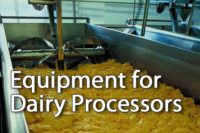
When specifying or designing dairy processing equipment, the first criterion is functionality for its purpose. But it is critical to remember that functionality includes cleaning and sanitizing. It is commonly thought that cleaning and sanitizing is the last step in the process, but it is not — it’s the first step.
We clean and then sanitize the cleaned equipment before we start processing. So when defining the functional requirements, it is critical to determine in advance how the equipment will be cleaned and sanitized. Will it be cleaned in place (CIP), cleaned out-of place (COP), or manually cleaned?
The methods of cleaning are defined in the “3-A General Requirements,” with COP and manual cleaning being closely related.
CIP
CIP involves the removal of soil from product contact surfaces in their process position by circulating, spraying or flowing chemical solutions and water rinses onto and over the surfaces to be cleaned. (Note: Components of the equipment that are not designed to be CIP are removed from the equipment to be COP or manually cleaned.)
COP
COP involves the removal of soil when the equipment is partially or totally disassembled. Soil removal is effected by circulating chemical solutions and water rinses in a wash tank, which may be fitted with a circulating pump(s).
Manual cleaning
Manual cleaning involves the removal of soil when the equipment is partially or totally disassembled. Soil removal is effected by chemical solutions and water rinses with the assistance of one brush or a combination of brushes, nonmetallic scouring pads and scrapers, and high- or low-pressure hoses, with cleaning aids manipulated by hand.
CIP considerations
Unless the equipment is designed to be completely CIP, it is important to be aware that often equipment intended for CIP has components that must be removed for COP or manual cleaning, including the personnel access ports and associated gaskets on silos and tanks. Usually the access ports are opened during CIP to allow the tanks to adequately vent and prevent them from collapsing.
These cleaning processes all require the same factors: time, mechanical action, chemicals, and temperature. They are just applied in a different manner for each process.
In CIP cleaning, the mechanical action is provided by direct impingement of spray streams, cascading action of CIP solutions flowing down the vessel sidewalls, or turbulent flow through pipelines at a minimum flow rate of 5 feet per second (1.5 mps).
CIP cleaning allows for higher temperatures and chemical concentrations than manual or COP cleaning due to the reduced personnel safety hazard, and it also reduces the labor required for COP or manual cleaning.
The CIP system itself is merely a tank or series of tanks with a pump, valving, heating system, and sensors used to recirculate cleaning and sanitizing solutions through the process equipment. Depending on the soil (product residues) conditions and product criteria, the systems can be single-use (recirculate solution and discharge to drain) or re-use (save the wash solutions for subsequent CIP cycles). Wash and rinse solutions can also be recovered to be used for pre-rinsing in the next cycle, but sanitizing solutions are never re-used.
CIP cleaning parameters should be documented by a chart or data recorder and the chemical concentrations verified by periodic chemical titration.
The critical criterion for CIP cleaning is that the process equipment must be designed for CIP. This includes the individual piece of process equipment, as well as the process piping. The 3-A symbol authorization lists equipment that is designed for CIP, COP or a combination of CIP and COP cleaning. A good example of this is a simple plug valve. Plug valves are very sanitary and easy to clean, but they are not CIP-able.
Additionally, 3-A Sanitary Practice 605-05 defines the requirements for the “Installation and CIP of Processing Equipment and Hygienic Pipelines.” This document provides details of the various types of CIP systems, typical CIP cleaning regimens and installation requirements for the piping systems.
Manual cleaning considerations
Manual cleaning is typically performed with a bucket of warm cleaning detergent and a dedicated brush (color-coded) to manually clean parts in processing such as personnel access covers and gaskets that cannot be easily removed for COP cleaning.
Sometimes foaming detergents are used with high-pressure spray hoses. The operator provides the mechanical action with the brush or spray hose, which can be quite effective, but it is generally not as efficient as other methods of cleaning due to the manual labor required
COP considerations
COP cleaning is used for parts that are not designed for CIP cleaning, and that can be disassembled and removed from the process equipment. The COP tank is like an equipment “Jacuzzi,” recirculating hot wash solutions through jets in the sides or ends of the vat over and through the components for a defined time to provide the turbulence (mechanical action) necessary for cleaning.
COP tanks can be provided with automatic or semi-automatic controls to dispense the detergents and control the temperature. The temperature and chemical concentration can be verified and documented on a chart recorder, and the solution can also be titrated to verify that it is correct.
It is extremely important that the components to be cleaned are not “nested,” which would prevent solution from contacting all the surfaces. Also, just laying a long pipe or hose in the bottom of a COP vat may not provide sufficient flow through the components to clean the inside.
Additional fixtures may be provided to flow solution through the inside of pipes and hoses, especially pipes with elbows. Racks or baskets are recommended to hold parts in proper locations so they are not just dumped into the bottom of the COP vat, where they may not be reliably cleaned.
After COP cleaning, the COP tank can be refilled with sanitizer to sanitize the components if necessary. After removal from the COP tank, a clean rack or cart should be provided so the cleaned/sanitized parts are not placed on the floor or dirty surfaces where they would be re-contaminated.
A newer alternative to the conventional COP tank is a cabinet washer. These are used to wash components in much the same way as an industrial dishwasher.
The components are mounted on a rack that rolls inside the cabinet washer, much like a dishwasher rack, to hold the parts in the proper position for spray coverage and to prevent nesting. Cabinet washers can automatically control the wash cycle and can record the wash time, conductivity, and temperature, much like a CIP system. Cabinet washers use approximately 1/10th (or less) of the water, energy, and chemicals as a conventional COP tank, with a programmable cleaning cycle, including sanitizing.
After the wash/sanitize cycle is complete, the rack with cleaned components can be rolled back to the process area to put them back in operation without re-contaminating them.
Regardless of the method of cleaning, all equipment should be inspected after washing to ensure that it is visibly clean and that all water has drained from vessels. Inspection can be done with a variety of tools, including a flashlight, inspection mirror or borescope, and ATP or micro swabs.
CIP, COP, and manual cleaning can all be effective ways to clean and sanitize food processing equipment, and each method serves a purpose. But it is essential that the intended method of cleaning and sanitizing is determined during the design phase of every project so equipment doesn’t show up in a plant, and the sanitation crew has to ask, “How are we going to clean that?”
Gabe Miller has 30 years of experience in cleaning and sanitizing equipment and is the owner of Process Innovation – Food Safety LLC, providing sanitary design guidance, training, sanitation audits, and 3-A CCE third-party verification inspections.


